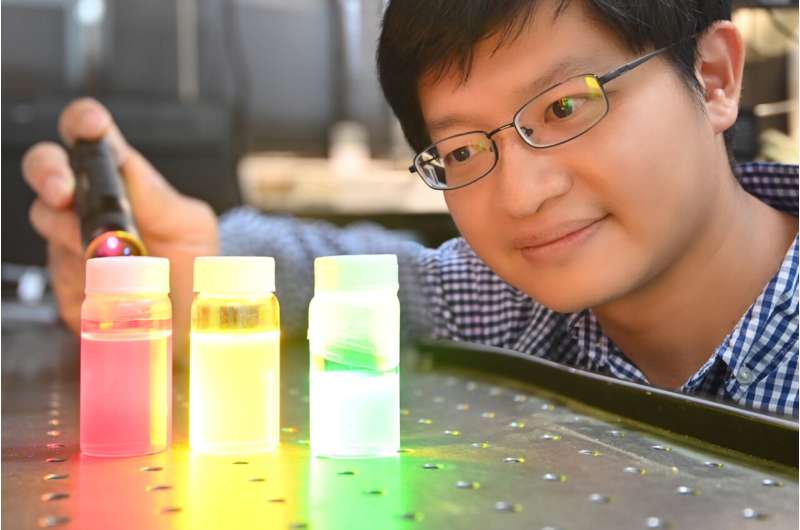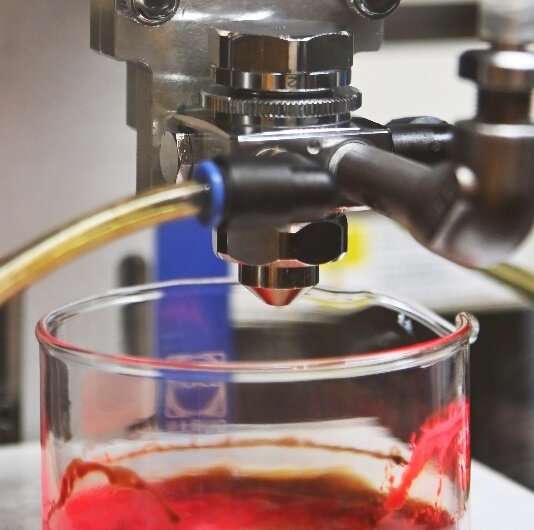Research team develops self-healing quantum emitter with unprecedented brightness

Perovskite quantum dots are the rising stars of quantum emitters, but their inherent instability has hampered their development. Professor Hao-Wu Lin of the Department of Materials Science and Engineering, Associate Professor Chih-Sung Chuu of the Department of Physics, and Professor Richard Schaller of the Department of Chemistry at Northwestern University in the United States have jointly developed a perovskite quantum emitter with high stability and self-healing ability by a self-developed, simple, and economical procedure—spray-synthesis method. The unprecedented single-photon brightness of these quantum dots breaks the world-record, which makes them become the brightest room-temperature quantum emitter materials and constitute a major breakthrough in both quantum communication and quantum computing.
Lin said that in contrast with other quantum emitters, perovskite quantum dots can realize single photon emission at room temperature and have excellent optical properties, such as high quantum yield and high color purity, making them ideal for displays and high-speed computing and communications. In recent years, perovskite quantum dots have attracted much attention among the international material community. However, their development has been hampered by their short operation lifetime, which can only survive under excitation for a few minutes.
The traditional method of preparing perovskite quantum dots is to directly inject and mix two different solutions. By contrast, Lin's research team has developed a spray-synthesis method which greatly increases the contact area of two different solutions, making it possible to grow a uniform protective organic layer on the surface of the quantum dots. Consequently, the perovskite quantum dots retain their brightness even after 24 hours of intensive continuous excitation, indicating that they overcome the poor stability of perovskite quantum dots.

Surprisingly, the perovskite quantum dots prepared in this way also have a unique self-healing ability. Although the quantum dots are damaged and decayed by extremely high-intensity excitation, they retrieve their original brightness after "resting" for just a few minutes. The team's research has been published in ACS Nano, and has also been chosen as the cover of the upcoming issue.
Lin compares researchers to chefs, and correlates preparing quantum dots with making dumplings. Some have tried using different materials, others have tried using thicker wrappers, and still others have tried doubling the wrappers, but he adopted a different approach: He simply kept on refining the method used for wrapping the dumplings.
The first author of the journal paper is NTHU doctoral student Bo-Wei Hsu. Recalling the moment when he first witnessed the self-healing capability of quantum dots, he said, "Following a period of strong excitation, the quantum dots gradually dimmed, but after a short while, they recovered their original brightness, and I could hardly believe my eyes!" Hsu did the experiments repeatedly and eventually confirmed that the quantum dots indeed possess this self-healing ability.
Lin pointed out that a perovskite quantum emitter prepared by this spray synthesis method requires only about 1% of the excitation intensity needed for other quantum emitters, and its single-photon brightness is as high as 9 million photons per second, which is a new world record. In addition, its single-photon purity is quite high as 98%.
More information: Bo-Wei Hsu et al, Very Robust Spray-Synthesized CsPbI3 Quantum Emitters with Ultrahigh Room-Temperature Cavity-Free Brightness and Self-Healing Ability, ACS Nano (2021). DOI: 10.1021/acsnano.1c00733
Journal information: ACS Nano
Provided by National Tsing Hua University





















